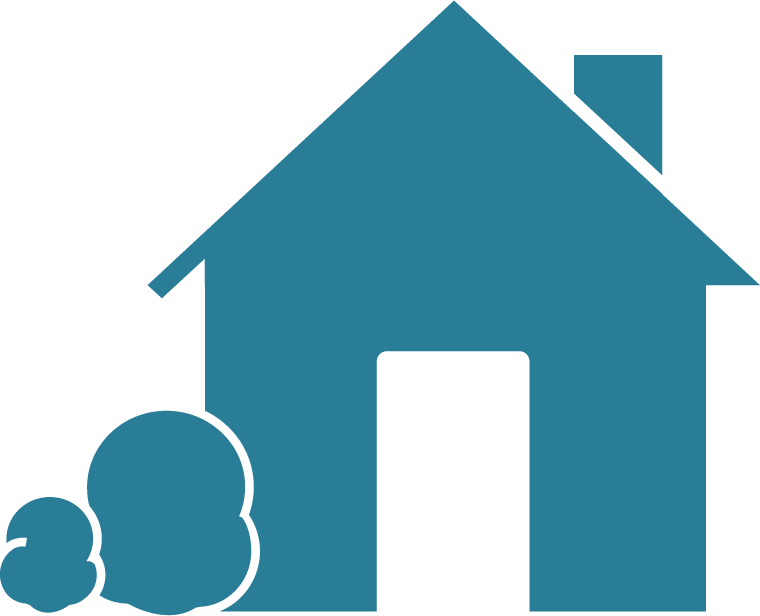Residential mental health care services
Summary
Residential mental health care (RMHC) services provide specialised mental health care on an overnight basis in a domestic-like environment. These facilities may provide a range of services including rehabilitation, treatment and extended care. Data from the National Residential Mental Health Care Database (NRMHCD) are used to describe the care provided by these services with data contributed by states and territories. More information about the NRMHCD is available in the data source section. Additional information on residential health care services can be found in the Specialised mental health care facilities section. For information on involuntary mental health legal status in residential mental health care services, refer to Involuntary treatment in mental health care.
Spotlight data
Number of residents, episodes, principal diagnoses and access by age group, 2005–06 to 2021–22
Infographic containing a pie chart showing proportions of 6 principal diagnosis categories 2021–22; a bar graph showing access by age group 2021–22; and a line chart showing the number and rate per 10,0000 population of residents and episodes of care from 2005–06 to 2021–22, (refer to Table RMHC.2 and Table RMHC.15).
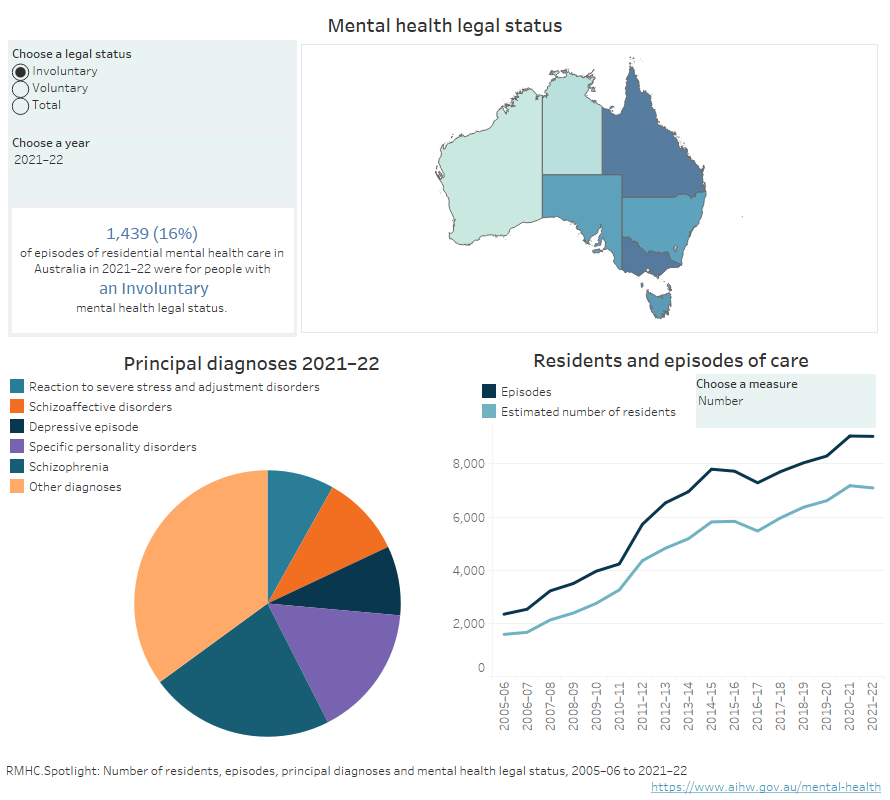
How many people access residential mental health care services?
There were about 9,000 continuing and completed episodes of residential care in 2021–22, 376,500 residential care days and an estimated 7,100 residents. This equates to about 40 residential care days per episode.
The provision of RMHC services differed between states and territories. Tasmania reported the highest rates (per 10,000 population) of episodes of care (13), estimated number of residents (10) and residential care days (about 690) (Figure RMHC.1).
Between 2012–13 and 2021–22, the estimated number of people across Australia accessing residential care increased from about 4,800 to 7,100 (Figure RMHC.Spotlight), and the rate of people (per 10,000 population) accessing care increased from 2 to 3.
Figure RMHC.1: Residential mental health care services in Australia by state or territory
Infographic containing a map of Australia showing residential mental health care episodes, estimated number of residents and residential care days (rate per 10,000 population and number), by state or territory.

Notes:
1. Comparisons between jurisdictions and years should be made with caution.
2. Australian Capital Territory did not report any residential mental health services from 2019–20 to 2021–22. National data excludes Australian Capital Territory.
Source: National Residential Mental Health Care Database; Table RMHC.2.
Resident demographics
People aged 18–24 years accessed care at a higher rate than other age groups (6 people per 10,000 population) in 2021–22. There were no residents aged under 12 years.
Aboriginal and Torres Strait Islander (First Nations) people comprised about 9% of residents in 2021–22 with a rate per 10,000 population that was almost 3 times the rate of other Australians (8 compared with 3).
People born in Australia accessed care in 2021–22 at about 3 times the rate for people born overseas (3 per 10,000 population compared with 1), with about 86% of residents born in Australia.
People in SEIFA quintile 1 (most disadvantaged) accessed care at a rate higher than all other quintiles (4 people per 10,000 population) and comprised 28% of the RMHC population (Figure RMHC.2).
Figure RMHC.2: People accessing residential mental health care, by resident demographics, 2021–22
Horizontal bar chart showing the rate (per 10,000 population), per cent or number of people accessing residential mental health care by demographic variables of age group, sex, First Nations status, country of birth, remoteness area and SEIFA quintile in 2021–22. Those aged 18-24 years had the highest rate at 6. There were no residents aged under 12 years. 2 males and 3 females per 10,000 population received residential mental health care services. 8 First Nations people per 10,000 population and 3 non-Indigenous Australians received residential mental health care services. 3 people per 10,000 population who were born in Australia and 1 people who were born overseas, received residential mental health care services. The highest rates for area of usual residence were Inner regional and Outer regional at 4 people per 10,000 population, while those in Major cities had the lowest rate of 2 people per 10,000 population. SEIFA Quintile 1 (most disadvantaged) had the highest rate of people receiving residential mental health care services at 4 per 10,000 population, while Quintiles 4 and 5 had the lowest at 2 (refer to Table RMHC.3).
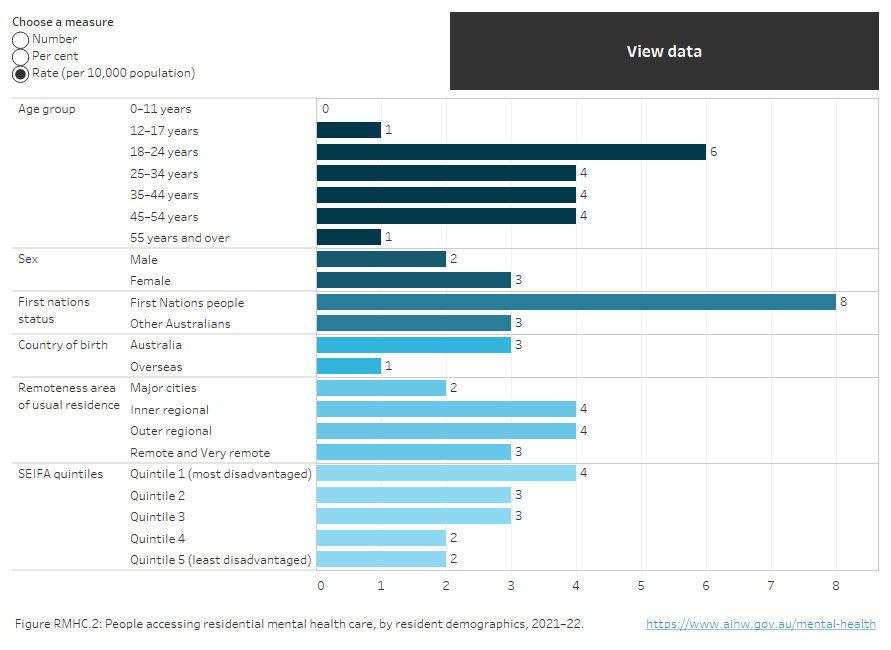
Source: National Residential Mental Health Care Database; Table RMHC.3.
Principal diagnoses
The 5 most commonly reported mental health-related principal diagnoses for residential mental health care episodes were:
- Schizophrenia (about 2,030 episodes, 22% of all episodes),
- Specific personality disorders (about 1,450, 16%),
- Schizoaffective disorders (about 900, 10%),
- Depressive episode (760, 8%), and
- Reaction to severe stress and adjustment disorders (about 730, 8%) (Figure RMHC.3).
Figure RMHC.3: Proportion of residential mental health care episodes for 5 commonly reported principal diagnoses, 2021–22
A horizontal bar chart showing the number of residential mental health care episodes with all principal diagnoses in 2021–22. Schizophrenia was recorded for 2,029 of residential mental health care episodes; Specific personality disorders, 1,454; Schizoaffective disorders, 895; Depressive episode, 760; and Reaction to severe stress and adjustment disorders, 733 (refer to Table RMHC.15).
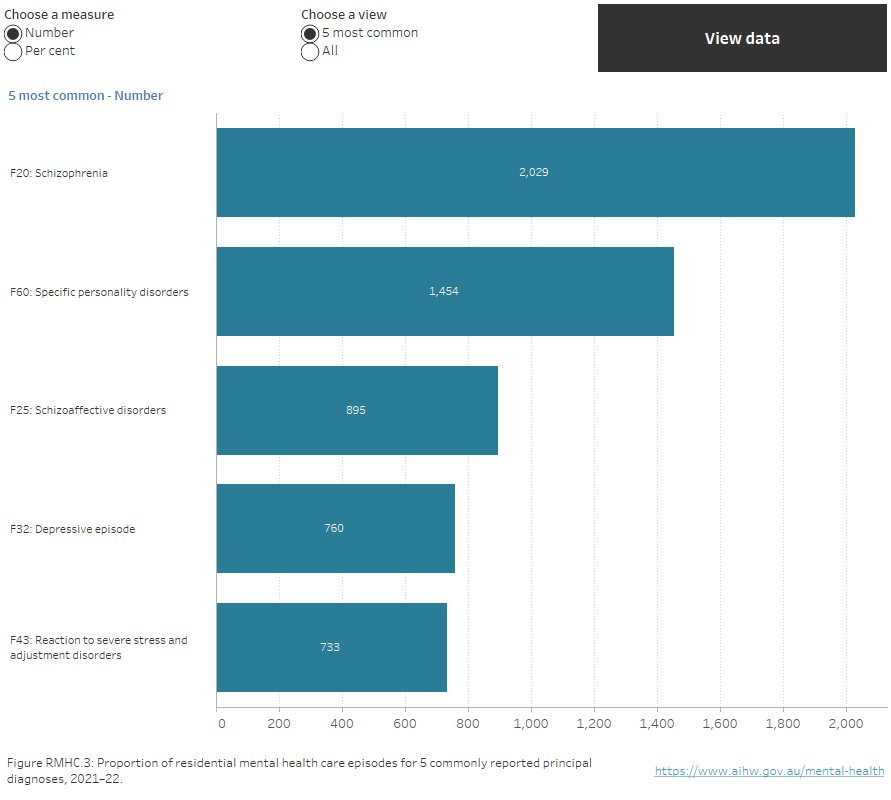
Source: National Residential Mental Health Care Database; Table RMHC.15
Characteristics of residential care episodes
In 2021–22, 7,950 residential episodes of care formally ended before the end of the reference period (on or before 30 June 2022). This is known as a completed residential stay. The most frequent episode length was 2 weeks or less (58%) (Figure RMHC.4) and a small number of episodes of care (3%) lasted longer than 1 but less than 5 years.
Figure RMHC.4: Residential mental health care episodes, by length of completed residential stay, 2006–07 to 2021–22
An interactive line chart showing the number of residential mental health care episodes by length of completed residential stay from 2006–07 to 2020–21. In 2020–21, episodes lasting between 0 to 2 weeks comprised 58% of episodes; between 2 weeks to 1 month, 27%; between 1 and 3 months, 7%; between 3 and 6 months, 3%; between 6 and 12 months, 2%; between 1 and 5 years, 3%; more than 5 years, 0% (refer to Table RMHC.9).
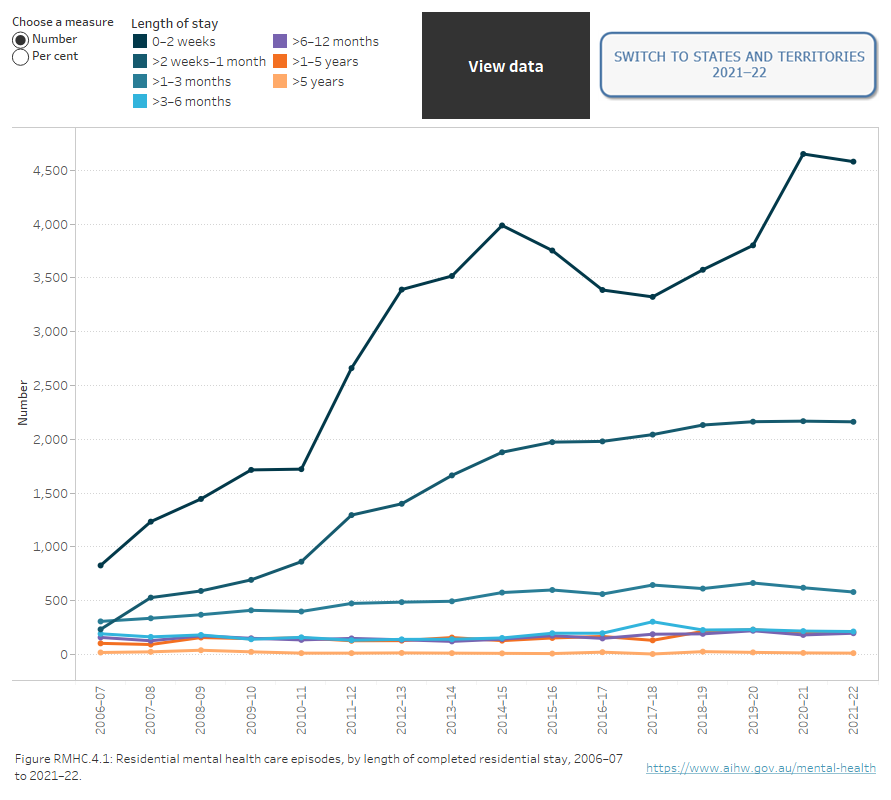
Source: National Residential Mental Health Care Database; Figure RMHC.4.1 – Table RMHC.9, Figure RMHC.4.2 – Table RMHC.8.
Where can I find more information?
National Residential Mental Health Care Database
The scope for this collection is all episodes of care in all government-funded residential mental health care (RMHC) services in Australia, except those RMHC services that are in receipt of funding under the Aged Care Act 1997 and subject to other Commonwealth reporting requirements. The inclusion of non‑government-operated services in receipt of government funding is optional.
Data Quality Statements for National Minimum Data Sets (NMDSs) are published annually via the AIHW’s Metadata Online Registry (METEOR). Statements provide information on the institutional environment, timeliness, accessibility, interpretability, relevance, accuracy and coherence. Previous years’ data quality statements are also accessible in METEOR.
In 2017–18, Queensland reclassified existing Community Care Units from admitted patient care to residential mental health service units.
For information related to staffing, beds and the number of RMHC facilities that provide specialised mental health care, visit the Specialised mental health care facilities section. More information about the coverage and data quality of this collection can be found in METEOR.
Key concepts
Key concept | Description |
|---|---|
Episodes of residential care | Episodes of residential care are defined as a period of care between the start of residential care, either through the formal start of the residential stay or the start of a new reference period (that is, 1 July) and the end of residential care, either through the formal end of residential care, commencement of leave intended to be greater than 7 days, or the end of the reference period (that is, 30 June). An individual can have one or more episodes of care during the reference period. |
Principal diagnosis | The principal diagnosis recorded for people who have an episode of residential mental health care is based on the broad categories listed in the Mental and behavioural disorders chapter (Chapter 5) of the International Statistical Classification of Diseases and Related Health Problems, 11th revision, Australian Modification (ICD-10-AM 11th edition). Further information can be found in the Health-related classifications section. |
Resident | A resident is a person who receives residential care intended to be for a minimum of 1 night. |
Residential care days | Residential care days refer to the number of days of care the resident received in the episode of residential care. The number of days a resident was in residential care is calculated by subtracting the date on which the residential stay started from the episode end date and deducting any leave days. These leave days may occur for a variety of reasons, including receiving treatment by a health service or spending time in the community. Note that leave days taken prior to 2009–10 were not accounted for due to lack of data. |
Residential mental health care | Residential mental health care refers to residential care provided by residential mental health services. A residential mental health service is a specialised mental health service that:
These services include those that employ mental health trained staff on-site 24 hours per day and other services with less intensive staffing. However, all these services employ on‑site mental health trained staff for some part of the day. |
Residential stay | Residential stay refers to the period of care beginning with a formal start of residential care and ending with a formal end of the residential care. It may involve more than one reference period (that is, more than one episode of residential care). |
Socio-Economic Indexes for Areas (SEIFA) | SEIFA is a product developed by the Australian Bureau of Statistics (ABS) that ranks areas in Australia according to relative socio-economic advantage and disadvantage. It consists of 4 indexes based on information from the 5-yearly Census, each being a summary of a different subset of Census variables and focuses on a different aspect of socio-economic advantage and disadvantage. Further details are available from the ABS. |
Data in this section were last updated in December 2023



